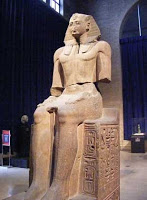Egypt
Reuters

 Thanks to Rick Menges for kindly sendly me a link to his album of photographs from the Penn Museum collection at webshots.com. It's worth visiting!
Thanks to Rick Menges for kindly sendly me a link to his album of photographs from the Penn Museum collection at webshots.com. It's worth visiting!
See the Reuters link above for more information.
- Exchange Of Prisoners With Metropolitan Museum Of Art
Penn Museum (Pam Kosty) When Penn Museum agreed to lend objects from its Egyptian collection to the Metropolitan Museum of Art for their new exhibition, The Dawn of Egyptian Art (April 10 through August 5, 2012), Penn Museum’s Egyptian section curator...
- Penn Museum Collections Now Online
Penn Museum The diverse, internationally acclaimed Collection hails from six continents and spans the millennia, shedding light on the vast scope of human activity and achievement. The permanent building to house the field notes and artifacts came more...
- New Director Wants To Open Museum's Trove
The Bay Citizen (Patrick Dillon) Not about Egypt exclusively, but about a museum which includes an Egyptian collection. An interesting insight into museum management, something I've always thought of as something of a thankless task due to the challenges...
- More Re Upenn Job Losses
philly.com (Faye Flam) Faced with a worsening deficit, the venerable, research-driven University of Pennsylvania Museum of Archaelogy and Anthropology is seeking to reinvent itself as an updated "tourist magnet." As an initial step, the director has laid...
- Exhibition: Penn In The World
huliq.com The University of Pennsylvania Museum of Archaeology and Anthropology has built its reputation both as a sponsor of groundbreaking fieldwork, and a center for research and education. It is fitting, then, when developing an exhibition about its...
Egypt
Penn Museum to share cultural treasures via internet
Reuters

 Thanks to Rick Menges for kindly sendly me a link to his album of photographs from the Penn Museum collection at webshots.com. It's worth visiting!
Thanks to Rick Menges for kindly sendly me a link to his album of photographs from the Penn Museum collection at webshots.com. It's worth visiting!The University of Pennsylvania's Museum of Archaeology and Anthropology, a national and world leader in its field since its founding in 1887, will create in September a "digital spine" in which all of its approximately 1 million objects will be catalogued on the internet.
The idea, said the museum's new director Richard Hodges, is to open up its collection of artifacts to scholars, researchers, and the general public around the world who have been unable to access it either because they are not in Philadelphia or because 95 percent of the objects are in storage.
The creation of an internet catalogue will provide unprecedented access to objects that represent the cultural heritage of civilizations that have been the source for the museum's many archaeological expeditions to remote parts of the world during the last 121 years.
Among the artifacts to be digitized will be the treasures from the royal tombs of Ur in southern Iraq, a famous collection from the Sumerian civilization of around 2500 BC, which was discovered in a joint expedition by Penn Museum and the British archaeologist C. Leonard Woolley in the late 1920s.
The Ur collection, which toured the U.S. in the 1990s, includes a bull-headed lyre, one of the oldest musical instruments in the world, an elaborate headdress, and jewelry of gold, lapis-luzuli, and carnelian.
Other objects from the Ur excavation are held in Baghdad, and at the British Museum, which is working with the Penn museum to create one virtual collection.
The new digital catalogue will also include objects from the museum's excavation of a pre-Columbian cemetery in Panama in the 1940s. That collection, shown to the public in the Rivers of Gold exhibition in 2007, contains 120 gold artifacts including plaques, nose ornaments, pendants and beads, as well as painted ceramics and objects made of bone, ivory and semi-precious stones.
See the Reuters link above for more information.
- Exchange Of Prisoners With Metropolitan Museum Of Art
Penn Museum (Pam Kosty) When Penn Museum agreed to lend objects from its Egyptian collection to the Metropolitan Museum of Art for their new exhibition, The Dawn of Egyptian Art (April 10 through August 5, 2012), Penn Museum’s Egyptian section curator...
- Penn Museum Collections Now Online
Penn Museum The diverse, internationally acclaimed Collection hails from six continents and spans the millennia, shedding light on the vast scope of human activity and achievement. The permanent building to house the field notes and artifacts came more...
- New Director Wants To Open Museum's Trove
The Bay Citizen (Patrick Dillon) Not about Egypt exclusively, but about a museum which includes an Egyptian collection. An interesting insight into museum management, something I've always thought of as something of a thankless task due to the challenges...
- More Re Upenn Job Losses
philly.com (Faye Flam) Faced with a worsening deficit, the venerable, research-driven University of Pennsylvania Museum of Archaelogy and Anthropology is seeking to reinvent itself as an updated "tourist magnet." As an initial step, the director has laid...
- Exhibition: Penn In The World
huliq.com The University of Pennsylvania Museum of Archaeology and Anthropology has built its reputation both as a sponsor of groundbreaking fieldwork, and a center for research and education. It is fitting, then, when developing an exhibition about its...
